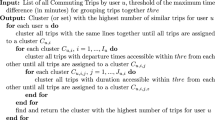Abstract
Tourist transportation usage analysis provides basic information for tourism policy making. With the technical advances of tracking devices, GPS-equipped smartphones sense the movement of tourists and generate extensive volumes of movement data detailing tourist trajectories. Many researchers study semantic annotation using machine learning. However, it is necessary for machine learning to label the data for training; this requirement is costly. It would be useful for GPS semantic annotation if labelling the substantial amounts of GPS data could be avoided. In this research, we propose a new, simple GPS semantic annotation method using environmental constraints without machine learning. We call this method Segment Expansion with Environmental Constraints (SEEC) and assume a tourist behaviour model in which tourists move by foot and public transportation in touristic destinations that include numerous locations of interest. SEEC inferred the transportation modes of the GPS trajectory data at a 90.4 % accuracy level in the experiment.
Access this chapter
Tax calculation will be finalised at checkout
Purchases are for personal use only
Similar content being viewed by others
References
Bolbol, A., Cheng, T., Tsapakis, I., & Haworth, J. (2012). Inferring hybrid transportation modes from sparse GPS data using a moving window SVM classification. Computers, Environment and Urban Systems, 36(6), 526–537.
Guc, B., May, M., Saygin, Y., & Korner, C. (2008). Semantic annotation of GPS trajectories. In 11th AGILE International Conference on Geographic Information Science. Girona, Spain.
Hemminki, S., Nurmi, P., & Tarkoma, S. (2013, November). Accelerometer-based transportation mode detection on smartphones. In Proceedings of the 11th ACM Conference on Embedded Networked Sensor Systems. New York, NY: ACM.
Liao, L., Fox, D., & Kautz, H. (2007). Extracting places and activities from GPS traces using hierarchical conditional random fields. International Journal of Robotics Research, 26(1), 119–134.
Reddy, S., Mun, M., Burke, J., Estrin, D., Hansen, M., & Srivastava, M. (2010). Using mobile phones to determine transportation modes. ACM Transactions on Sensor Networks (TOSN), 6(2), 13.
Parent, C., Spaccapietra, S., Renso, C., Andrienko, G., Andrienko, N., Bogorny, V., & Yan, Z. (2013). Semantic trajectories modeling and analysis. ACM Computing Surveys (CSUR) 45(4), 42.
Pearce, P. L. (2005). Tourist behaviour: Themes and conceptual schemes. Bristol: Channel View Publications.
Potamias, M., Patroumpas, K., & Sellis, T. (2006). Sampling trajectory streams with spatiotemporal criteria. In Scientific and Statistical Database Management, 2006. 18th International Conference (pp. 275–284). Vienna: IEEE.
Stenneth, L., Wolfson, O., Yu, P. S., & Xu, B. (2011, November 1–4). Transportation mode detection using mobile phones and GIS information. ACM SIGSPATIAL GIS ’11, Chicago, IL.
Stopher, P., Clifford, E, Zhang, J., & FitzGerald, C. (2008). Deducing mode and purpose from GPS data. In The 87th annual meeting of the transportation research board, Washington, DC.
Yan, Z., Chakraborty, D., Parent, C., Spaccapietra, S., & Aberer, K. (2011, March). SeMiTri: A framework for semantic annotation of heterogeneous trajectories. In Proceedings of the 14th International Conference on Extending Database Technology (pp. 259–270). New York, NY: ACM.
Yan, Z., Chakraborty, D., Parent, C., Spaccapietra, S., Aberer, K. (2013). Semantic trajectories: Mobility data computation and annotation. ACM Transactions on Intelligent Systems and Technology (TIST) 4(3), 49.
Zheng, Y., Chen, Y., Li, Q., Xie, X., & Ma, W. Y. (2010). Understanding transportation modes based on GPS data for web applications. ACM Transactions on the Web (TWEB) 4(1), 1.
Author information
Authors and Affiliations
Corresponding author
Editor information
Editors and Affiliations
Rights and permissions
Copyright information
© 2015 Springer International Publishing Switzerland
About this paper
Cite this paper
Kasahara, H., Mori, M., Mukunoki, M., Minoh, M. (2015). Transportation Mode Annotation of Tourist GPS Trajectories Under Environmental Constraints. In: Tussyadiah, I., Inversini, A. (eds) Information and Communication Technologies in Tourism 2015. Springer, Cham. https://doi.org/10.1007/978-3-319-14343-9_38
Download citation
DOI: https://doi.org/10.1007/978-3-319-14343-9_38
Published:
Publisher Name: Springer, Cham
Print ISBN: 978-3-319-14342-2
Online ISBN: 978-3-319-14343-9
eBook Packages: Business and EconomicsBusiness and Management (R0)




